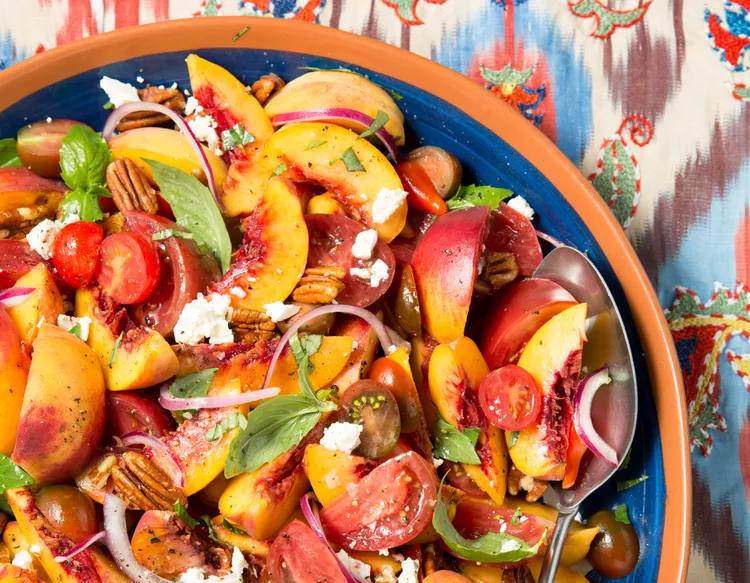7 Naturally Hydrating Foods You Should Keep on Hand All Summer Long

Getting adequate hydration each day is easier said than done. But fear not: Hydration can be achieved through more than just water consumption, with a diet of foods that nourish and moisturize from the inside out. We chatted with plant-based registered dietitian Amy Gorin, MS, RDN, as well as celebrity cosmetic dermatologist Dr. Paul Jarrod Frank, author of The Pro-Aging Playbook , for their takes on the most hydrating foods you can find, as well as their top tips for staying hydrated.
- Amy Gorin, MS, RDN is the founder of Plant Based with Amy, a resource for consuming more plant-based foods.
- Dr. Paul Jarrod Frank is a celebrity cosmetic dermatologist and the author of The Pro-Aging Playbook.
7 Expert-Recommended Hydrating Foods
Here are the most hydrating foods our experts suggest you start consuming to prevent poor or low hydration symptoms.
Citrus Fruits
“If you purchase 100% Florida orange juice, it is about 89% water!” says Gorin. Other citrus fruits, like grapefruit, boast similar hydration levels. “Just make sure you are not taking any medications that would negatively interact with it.”
Citrus fruit lovers will also benefit from an abundance of immune system-supporting properties like vitamin C and flavonoid antioxidants.
Cucumbers
Not only is cucumber (made of 95% water!) a hydrating food, but it also contains vitamins and nutrients that can rid the body of excess fluid.
“Cucumbers are water-packed and loaded with vitamin C,” claims Frank.
Mangoes
Fibrous and starchy mango may not be the first thing you think of as a hydrating food, but it contains more than 80% water content. Gorin recommends adding a few slices to your oatmeal for double the benefit.
Oatmeal
Hearty oatmeal is a comforting breakfast staple and an excellent way to increase your H2O intake.
“To cook oatmeal, you need to add water,” Gorin says. Although much of it evaporates when microwaved or prepared on a stove top, runnier oatmeal is still a more hydrating food than a bowl of dry cereal with barely any milk. And if you can’t stomach the idea of a hot meal on an even hotter day, consider overnight oats, which are typically eaten cold.
“Plus, it provides filling soluble and insoluble fibers, which means that eating oats will help bulk up the weight and size of your stool,” Gorin adds, making it a good choice for those who frequently suffer from diarrhea, which can be dehydrating.
Peaches
Stone fruits like peaches are some of the most water-heavy fruits you can find, with levels exceeding 90%. “In addition to that water, you also get vitamins, minerals, antioxidants, and fiber,” says Gorin.
Soup
It may seem like a no-brainer, but soups made with vegetable or chicken broth can be very hydrating foods.
“I love to recommend broth-based soups such as minestrone or vegetable,” shares Gorin, though she and Frank are quick to point out that many canned or packaged varieties are loaded with sodium, which can cause dehydration of the skin.
Tomatoes
Perhaps the most hydrating food on this list is tomatoes, due mostly to the presence of lycopene—a powerful antioxidant that research has shown to protect the skin.
More Quick Tips for Staying Hydrated
If you’re not a fan of these hydrating foods or want other ideas to ensure you’re getting enough water, keep these things in mind:
Drink a Lot of Liquid
“I like to tell people to think of hydrating foods as bonus hydration,” says Gorin. “So aim to drink the base of your water—which can come from plain water, seltzer, tea, and even a few cups of black coffee. And then when you eat water-rich foods like fruits, vegetables, and soup, you are getting bonus hydration that will work to help your body function even better.”
Consistency Is Key
Don’t munch on these hydrating foods once and expect to see an immediate reaction.
“Aim to include them in every meal and snack so that you stay properly hydrated,” says Gorin. “Hydration is important for so many things, even unexpected ones like mental clarity and preventing headaches. ... Consider these additions as lifestyle enhancements.”